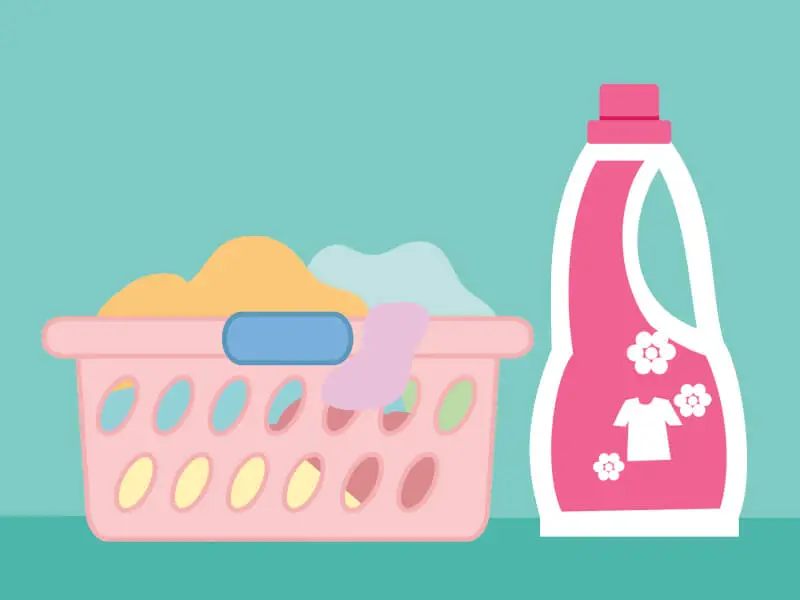
Children will acquire a variety of stains on their clothing- especially when playing.
Clothes these days are costly, and to avoid demoting a nice shirt or pair of pants to the “rag” pile or “weekend only” clothing section of their wardrobe, you must be able to effectively remove a variety of stains.
In this article I’ll cover the most common stains children pick-up while playing and how you can remove them safely and effectively.
Table of Contents
Common Playground Stains and How to Remove Them
The most common playground stains include grass, tire/rubber marks, dirt, mud, blood, tree sap, and juice drinks. There are plenty of stain removal techniques out there, and below I list the ones that actually work based on decades of experience with two rowdy boys.
There is often more than one way to remove a stain, and I include 2-3 removal methods for each type of stain. They all work equally well, and I’m sure you’ll find one that fits your needs.
Grass
Grass is one of the most common and stubborn stains that children get on their clothing. But no need to worry, each of the methods below will remove grass stains.
Grass Stain Removal – Method 1
1. Soak just the stained area of clothing for a minimum of 15 minutes in a homemade solution of 1 part water and 1 part white distilled vinegar.
2. Use a toothbrush or any soft-bristled brush to scrub the stain out.
3. If any of the grass stains remain, simply put laundry detergent directly on the stain and scrub to lift it off.
3. Wash the blemished garment using an enzyme-based washing detergent.
Enzyme-based cleaners and laundry detergents help to break down the biological components of the stain, which helps to remove and lift them from clothing.
Grass Stain Removal – Method 2 (White Clothes)
1. Soak just the stained area of clothing in a homemade solution of 2 parts hydrogen peroxide and 1 part liquid dish soap or detergent for around 15 minutes.
2. After you have soaked the stain, brush the stained area using an old toothbrush or gentle scrub brush.
3. Repeat the brushing if the stain is not totally eliminated.
4. Rinse with hot water and launder in the washing machine.
Tip – Do not dry the clothes after washing if some marks still remain because it will only set the stain.
Tire/Rubber Stains
Tire marks refer to the rubber particles left behind on children’s clothes, which usually happens when playing on rubber mulch or a tire swing.
Tire/Rubber Stain Removal – Method 1
1. Apply eucalyptus or tea tree oil on a clean piece of wash rag.
2. Wipe the tire marks with the rag. Oils break up the rubber wedged in the fibers to release them. Repeat the process until the stains are removed.
3. Spray cold water on the oily portion. Use a clean and dry towel to pat the oil from the garment. Continue the procedure until there is no oil residue left.
4. Wash the clothing as usual.
Tire/Rubber Stain Removal – Method 2
Another option that works for tire/rubber stains (and many others) is to use a cleaning agent called TSP (tri-sodium phosphate). TSP is highly effective, however, it can be harsh on the skin so wear rubber gloves while using.
1. Mix a small amount (1/2 teaspoon) with 2 tablespoons of water and apply directly to the stain.
2. With a clean rag or soft brush lightly scrub the stain until it’s removed.
3. Once removed wash normally.
Dirt/Mud Stains
Dirt and mud sticks on children’s clothing during outside play- especially on rainy days. This is not a problem with these easy-to-follow steps.
Dirt/Mud Stain Removal – Method 1
1. If the dirt/mud has dried, scrape away as much as you can with a dull knife (butter knife).
2. Apply liquid laundry detergent directly on the stained area of clothing.
3. Scrub the stain with a wet toothbrush or soft brush.
4. If washing the mud-stained item with other clothes, rinse first before washing so you won’t spread the dirt which will make other clothes dingy.
5. After washing, consider air-drying the garment so you can be positive the stain is removed as drying will set stains.
Dirt/Mud Stain Removal – Method 2
Use an oxygen-based detergent. Look for the best brand on the market such as Oxi Clean.
1. Combine the oxygen-based bleach with clean tap water.
2. Soak for a minimum of 2 hours or overnight for larger and “heavier” stains.
3. Wash after soaking.
Tip – If washing the stained garment with other clothes, rinse first.
Dirt and mud are unavoidable enemies in washing. These should be handled properly to avoid permanent stains.
Blood Stains
Blood stains are significantly easier to remove when wet although you can still remove them even if the blood has dried up.
Tip – Until the blood stain is completely removed always use cold water.
Blood Stain Removal – Method 1 (dried blood, white clothes)
1. Soak the blood stain clothing in cold water for at least 30-60 minutes.
2. Mix 2 parts hydrogen peroxide with 1 part liquid dish soap and apply the homemade solution directly to the freshly “cold-soaked” stain.
3. Scrub the stain with a toothbrush or other soft or medium bristle brush until the stain starts to lift.
4. As the stain lifts rinse it out with cold water and repeat until the blood is completely removed.
5. Wash as usual, just make sure to use cold water.
6. Allow to air dry and inspect the garment to make sure the blood is completely removed. If some still remains, repeat the process.
Blood Stain Removal – Method 2 (dried blood, colored clothes)
1. Soak the blood stained clothing in cold water for a minimum of 30-60 minutes. (This helps to break up the blood)
2. Mix 1 part ammonia, 1 part water, and 1 part liquid dish soap. Apply the homemade solution directly to the freshly “cold-soaked” blood stain.
Never mix ammonia with bleach, this will produce a highly toxic chlorine gas.
3. Using a clean rag, toothbrush, or any soft-bristle brush, gently scrub in the solution.
4. As the blood separates from the clothing, rinse with cold water. Repeat until the blood is completely removed.
5. Was as usual with cold water.
6. Air-dry the garment to make sure the blood is completely removed as drying will set the stain.
Blood Stain Removal – Method 3 (wet blood)
1. Immediately soak the blood stained clothing in a sink or tub of cold water. You may have to drain and add fresh water a few times.
2. Continue to let the garment soak in the cold water for a minimum of 30-60 minutes.
3. Rub the main area of the stain with a bar of soap (Don’t worry if the water soak turned some areas pink, just get the darkest part of the stain). Really rub it in and work up a good lather.
4. Rinse in fresh, cold water and repeat if necessary until the stain is removed.
5. Wash as usual in cold water. Make sure to use a good enzyme-based laundry detergent. (Most popular brands such as Tide are enzyme-based).
6. Allow to air-dry to be sure the stain is completely removed as drying will set the stain.
Tip – After the stain is removed and it’s time to wash, add a cup of white distilled vinegar into your machine for extra stain removal.
Tree Sap
Dried sap from trees can definitely prove to be a headache. It sticks to fibers and turns into a stubborn mark that can stay on clothes through 20 or more washes.
Stain-removing agents such as rubbing alcohol and laundry detergent are useful in dealing with tree sap stains.
Tree Sap Removal – Method 1
1. For larger chunks of sap on clothing, freezing the sap makes it much easier to come off. Put the sap stained garment in the freezer and leave for a minimum of 1 hour.
If your freezer is full or you don’t have access to one, place a pack of ice directly on the sap and let sit for 30-60 minutes, or for as long as the ice will stay solid.
2. Scrape off the frozen, now brittle sap using a rounded butter knife.
3. Pour a stain remover laundry detergent directly on the left over sap and scrub with a toothbrush or any clean, soft or medium bristle brush.
4. Blot the sap up, with a clean rag, lifting the stain. Repeat if necessary.
Tree Sap Removal – Method 2 (white clothes)
Rubbing alcohol can “bleach” fabric, so be sure to use only on white clothing.
1. Pour white rubbing alcohol on a soft white cloth. Be sure to use a white cloth to ensure that dye does not transfer to the fabric stained with sap.
2. Blot the alcohol-soaked rag all over the sap until the stain is fully soaked.
3. Rubbing alcohol will dissolve the sap, so just blot and wipe the stain off with the rag.
4. After the sap has lifted, scrub the area with a soapy rag. You can use laundry detergent, liquid soap, or scrub a bar of soap directly on the stain.
5. Wash the garment normally using hot or warm water.
Tree Sap Removal – Method 3
1. Mix a little amount of non-bleach powdered detergent with a few drops of water to come up with a paste mixture.
2. Apply the paste on the stain, rub in, and allow to stand for 20-30 minutes.
3. (Optional) For best results, add a little water directly to the soaking stain and heat up with a hairdryer.
4. With a clean rag or toothbrush, scrub the stain. The sap will start to lift. Dab and wipe off the sap as it lifts with a clean rag.
5, Wash the clothing normally using warm or hot water.
Juice Stains
Children love to drink fruit juices, especially during playtime.
The downside is that parents may encounter challenges in removing juice stains from their clothes.
In all-natural juices, stains usually come from tannin, the plant component that produces the color in fruits.
Juice Stain Removal – Method 1 (wet juice stains)
1. Blot the wet juice with paper towels or a clean white cloth, soaking up as much as you can.
2. For large stains it may be easier to flush the stained portion with running warm water, just make sure to turn the clothing inside out.
3. Directly add an enzyme-based laundry detergent directly to the stain and scrub it out with a rag.
4. If any of the stain remains, just soak the garment in warm (not hot, hot water may set the stain) water for 30-60 minutes and repeat the cleaning.
5. Wash as usual in warm water.
Juice Stain Removal – Method 2 (dried juice stains)
Older, dried juice stains will require a little more work, but they can still be removed.
1. Soak the garment for at least 4 hours or overnight in non-hot water.
2. Mix 2 parts white distilled vinegar, 2 parts lemon juice, 1 part liquid dish soap and apply directly to the “freshly soaked” juice stain.
3. Let sit for 5-10 minutes.
4. Using a toothbrush, or soft-bristled brush, scrub the stain and rinse the garment.
5. Repeat until all of the stain is removed.
6. Wash normally using warm water.
7. Allow the garment to air dry to ensure the stain is completely removed, as drying will set the stain.
Final Thoughts and Considerations
When it comes to removing stubborn stains, don’t disregard the traditional “long soak” method.
Place a substantial scoop or cap of laundry detergent into a sink, tub, or washing machine and allow the garment to soak overnight.
Adding an oxygen-based detergent or chlorine bleach (for white clothes) will aid in stain removal.
Remember to stay safe and have fun!

Kathryn
Over 14 years in special education with a BA in psychology. I work daily with children of all kinds, with a special focus on childhood development and play using music and play equipment among other tools.

